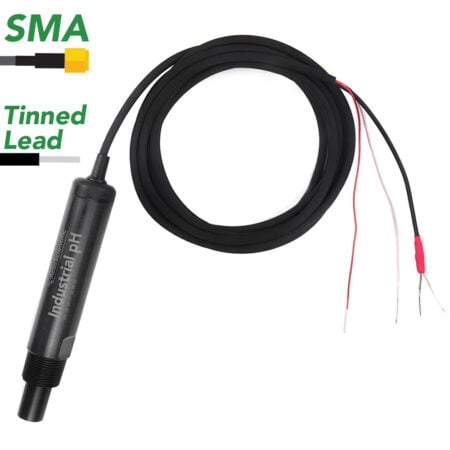Subtotal: $159.99

10 Sensors For Greenhouse Monitoring – A Guide To Precision Agriculture
Greenhouse monitoring is the backbone of precision agriculture, and it starts with the right sensors. The 10 most essential sensors to optimize crop health and
Product Categories

When the pH of soil becomes acidic, it can have detrimental effects on plant health. To increase the pH of soil, a component that contains calcium and/or magnesium is used. The most common practice is to add a material that contains lime, however other methods such as using baking soda or eggshells will also increase the pH in soil.
Measuring pH is important as plants rely on the correct pH to absorb nutrients to survive and thrive, making it an essential part of maintaining a healthy garden. Most plants require a pH level between 6.0 and 7.5, however, it is important to research the pH requirements for the particular plant you are growing.
To successfully grow plants, testing the soil will help you learn the current pH levels, and if you need to make any changes. If you need to increase or decrease the pH in the soil, there are many common compounds you can add to soil, and once the correct pH is met, you should have healthy and productive plants.
The pH value of soil is mostly affected by the parent materials when the soil is formed. Soils that are developed from basic/alkaline rocks usually have a higher pH value than soils formed from acidic rocks.
The pH of the soil is also influenced by rainfall when water passes through the soil layers, usually turning the soil more acidic due to acidic elements replacing leached alkaline nutrients like calcium and magnesium.
Ammonia or urea found in fertilizers and the decomposition of organic matter can also decrease the pH in the soil, thus making it more acidic.
Before you increase or decrease the pH in soil, there are a few factors you need to consider.
Firstly, it is important to identify what type of soil you have. For example, is it dry, loose, wet, clumpy, or more than one of those characteristics?
It is easier to change the pH of the soil if it is well-drained and loose, compared to compact soil that has a high clay content. Determining which soil type you have will help find the best way to alter the pH.
Next, would be to understand soil pH.
A soil’s pH tells you how acidic or alkaline it is, running on a scale from 0 to 14, with 7 being neutral, >7 alkaline (or basic), and <7 acidic. As previously mentioned, most plants require a pH level between 6.0 and 7.5, this is also the best pH range for earthworms and microorganisms that benefit your plants.
After you know your soil type and what soil pH is, consider what type of plant you want to grow, as this will determine the pH range. For example:
If what you are growing is not listed above, research the recommended pH levels or speak to your local garden store.
Ok, so you have identified which soil type you have, what you are wanting to grow, and have a good idea of which soil pH is, finally, you should test the pH of the soil and your water supply.
To test the pH in the soil, you can buy a pH probe/sensor and test at home, but if you are not quite there yet, then you can send a sample to your nearest garden store. To test your water supply the same pH probe can be used.
The easiest and most efficient way to measure the pH of soil is with a pH probe or sensor. However, you can also use qualitative pH test strips, which will give you a general color-scale range.
Using an Atlas Scientific pH probe to measure the pH in the soil can be done in 4 easy steps:
The most common method to raise the pH in the soil is to apply a material that contains some form of lime. Lime/limestone is used because it contains calcium, magnesium, or both, which are both alkaline components.
Dolomite Lime: Dolomite limestone (calcium magnesium carbonate) is commonly used among organic and conventional farmers to increase the pH of soil, but it can also be used in your home too.
However, if your soil already has high magnesium content, this method should not be used as excess magnesium can stunt growth and in severe cases, you may experience crop loss. Therefore, before using dolomite lime, test the magnesium levels in the soil, and if your soil has a high magnesium level, use a different form of lime.
Oyster Shell Lime: Using finely ground oyster shell lime is entirely organic, it contains up to 39% calcium, and not only can it be used to raise the pH level in soils, but it also can be used to correct calcium deficiencies within the soil.
Agricultural Lime: Made from pulverized limestone/chalk, this method is commonly used. However, it is important to note that agricultural lime soil additives sometimes contain other chemicals such as calcium oxide, magnesium oxide, and magnesium carbonate.
Hydrated Limestone: Despite hydrated pulverized limestone being the fastest method to increase the pH in soil, it is not often used because it is very easy to overdose the soil. If you overdose the soil, you will burn your plant’s roots.
Note, that with all the above lime products, always check the manufacturer’s dosing instructions to avoid overdosing.
After using lime, baking soda is the best way to increase the pH in soil, plus it is one of the easiest, fastest, and most cost-effective methods. Baking soda is also a very gentle method, so you do not need to worry about harming your plants.
Dried and pulverized eggshells are also an excellent way to make your soil more alkaline because eggshells have a high calcium content.
Finally, wood ashes can be used because they contain a high amount of potassium and calcium. While using wood ashes is not as effective as limestone, with continuous use, wood ash can drastically increase the pH in soils. If you use this method, ensure that the wood ashes do not come into contact with germinating seedlings or plant roots, as they can become damaged.
Understanding how to decrease the pH in the soil is just as important as increasing the pH, in the event you have exceeded the soil’s pH level, or your plant requires acidic soil.
The two ways to decrease the pH in soil are with:
When aluminum sulfate dissolves into the soil, it rapidly decreases the pH. As sulfur forms sulfuric acid with the aid of soil bacteria, it takes some time for the soil to become acidic. Therefore, aluminum sulfate is the preferred option.
Soils require a certain pH to successfully grow plants.
If you wish to adjust the pH in soil, start with measuring the current pH of the soil, then understand the target pH for your plants. The best way to increase the pH in soil is using a lime-based compound such as dolomite lime and agricultural lime. However, other methods such as using baking soda, crushed eggshells, or wood ashes can also be used.
If you have any questions regarding the pH in soil, or are unsure which pH probe will best suit your needs, do not hesitate to contact our world-class team at Atlas Scientific.







Greenhouse monitoring is the backbone of precision agriculture, and it starts with the right sensors. The 10 most essential sensors to optimize crop health and

Hydroponics has revolutionized the way people grow food, offering soil-free methods that deliver nutrients directly to plant roots in water-based systems. But success in hydroponics